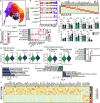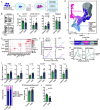This is a preprint.
Integrated single cell analysis shows chronic alcohol drinking disrupts monocyte differentiation in the bone marrow niche
- PMID: 37034734
- PMCID: PMC10081177
- DOI: 10.1101/2023.03.29.534727
Integrated single cell analysis shows chronic alcohol drinking disrupts monocyte differentiation in the bone marrow niche
Update in
-
Integrated single cell analysis shows chronic alcohol drinking disrupts monocyte differentiation in the bone marrow.Stem Cell Reports. 2023 Sep 12;18(9):1884-1897. doi: 10.1016/j.stemcr.2023.08.001. Epub 2023 Aug 31. Stem Cell Reports. 2023. PMID: 37657446 Free PMC article.
Abstract
Chronic alcohol drinking rewires circulating monocytes and tissue-resident macrophages towards heightened inflammatory states with compromised anti-microbial defenses. As these effects remain consistent in short-lived monocytes after a 1-month abstinence period it is unclear whether these changes are restricted to the periphery or mediated through alterations in the progenitor niche. To test this hypothesis, we profiled monocytes/macrophages and hematopoietic stem cell progenitors (HSCP) of the bone marrow compartment from rhesus macaques after 12 months of ethanol consumption using a combination of functional assays and single cell genomics. Bone marrow-resident monocytes/macrophages from ethanol-consuming animals exhibited heightened inflammation. Differentiation of HSCP in vitro revealed skewing towards monocytes expressing neutrophil-like markers with heightened inflammatory responses to bacterial agonists. Single cell transcriptional analysis of HSCPs showed reduced proliferation but increased inflammatory markers in mature myeloid progenitors. We observed transcriptional signatures associated with increased oxidative and cellular stress as well as oxidative phosphorylation in immature and mature myeloid progenitors. Single cell analysis of the chromatin landscape showed altered drivers of differentiation in monocytes and progenitors. Collectively, these data indicate that chronic ethanol drinking results in remodeling of the transcriptional and epigenetic landscapes of the bone marrow compartment leading to altered functions in the periphery.
Conflict of interest statement
Competing interests
No competing interests reported.
Conflict-of-interest
The authors have declared that no conflict of interest exists.
Figures





Similar articles
-
Integrated single cell analysis shows chronic alcohol drinking disrupts monocyte differentiation in the bone marrow.Stem Cell Reports. 2023 Sep 12;18(9):1884-1897. doi: 10.1016/j.stemcr.2023.08.001. Epub 2023 Aug 31. Stem Cell Reports. 2023. PMID: 37657446 Free PMC article.
-
Transcriptional and Epigenetic Regulation of Monocyte and Macrophage Dysfunction by Chronic Alcohol Consumption.Front Immunol. 2022 Jun 29;13:911951. doi: 10.3389/fimmu.2022.911951. eCollection 2022. Front Immunol. 2022. PMID: 35844518 Free PMC article. Review.
-
Daily Ethanol Drinking Followed by an Abstinence Period Impairs Bone Marrow Niche and Mitochondrial Function of Hematopoietic Stem/Progenitor Cells in Rhesus Macaques.Alcohol Clin Exp Res. 2020 May;44(5):1088-1098. doi: 10.1111/acer.14328. Epub 2020 Apr 21. Alcohol Clin Exp Res. 2020. PMID: 32220015 Free PMC article.
-
Transcriptional, Epigenetic, and Functional Reprogramming of Monocytes From Non-Human Primates Following Chronic Alcohol Drinking.Front Immunol. 2021 Aug 20;12:724015. doi: 10.3389/fimmu.2021.724015. eCollection 2021. Front Immunol. 2021. PMID: 34489976 Free PMC article.
-
[Niche signals regulate differentiation and functions of tissue resident macrophages].Rinsho Ketsueki. 2018;59(10):1886-1894. doi: 10.11406/rinketsu.59.1886. Rinsho Ketsueki. 2018. PMID: 30305489 Review. Japanese.
References
-
- (WHO) WHO. 2018.
-
- O’Keefe JH, et al. Alcohol and cardiovascular health: the dose makes the poison...or the remedy. Mayo Clin Proc. 2014;89(3):382–93. - PubMed
-
- Fedirko V, et al. Alcohol drinking and colorectal cancer risk: an overall and dose-response meta-analysis of published studies. Ann Oncol. 2011;22(9):1958–72. - PubMed
-
- Baan R, et al. Carcinogenicity of alcoholic beverages. Lancet Oncol. 2007;8(4):292–3. - PubMed
Publication types
Grants and funding
LinkOut - more resources
Full Text Sources
Research Materials
